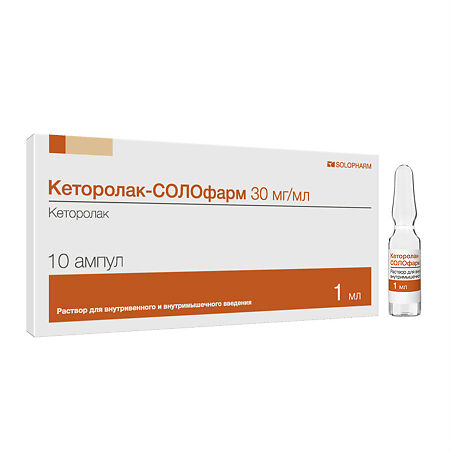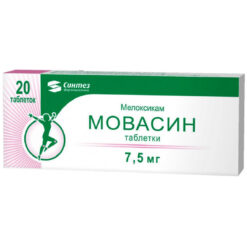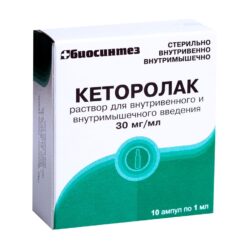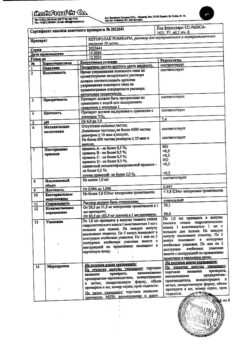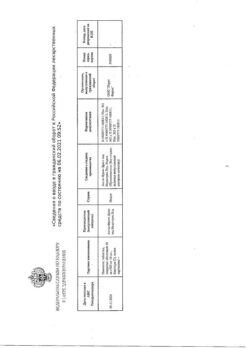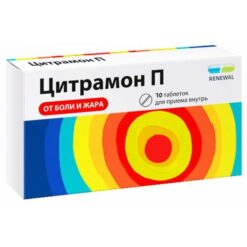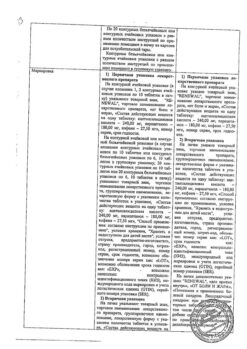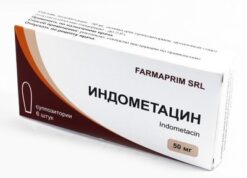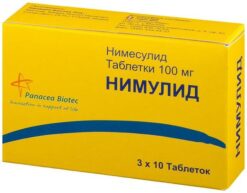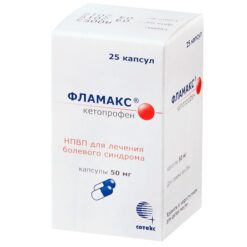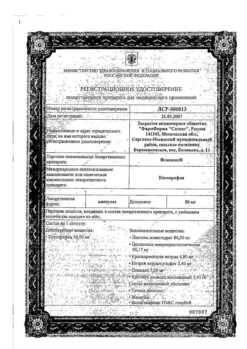No products in the cart.
Ketorolac-Solopharm, 30 mg/ml 1 ml 10 pcs
€4.49 €3.74
Description
A nonsteroidal anti-inflammatory drug.
The ATX code: M01AB15
Pharmacological properties
Pharmacodynamics
Ketorolac refers to non-steroidal anti-inflammatory drugs (NSAIDs), has a pronounced analgesic effect, also has anti-inflammatory and moderate antipyretic effects.
The mechanism of action is associated with non-selective inhibition of cyclooxygenase 1 (COX 1) and cyclooxygenase 2 (COX 2) activity, catalyzing formation of prostaglandins (Pg) from arachidonic acid, which play an important role in the pathogenesis of pain, inflammation and fever. Ketorolac is a racemic mixture of [-]S and [+]R enantiomers, and the analgesic effect is due to the [-]S form. It is comparable with morphine in analgesic effect and is significantly superior to other NSAIDs. The onset of analgesic action is noted after 0.5 h, the maximum effect is reached after 1-2 h and lasts about 4-6 h.
Pharmacokinetics
Absorption
Bioavailability is complete and fast. After intramuscular administration of 30 mg, maximum concentration (Cmax) is 1.74-3.1 mcg/ml, 60 mg – 3.23-5.77 mcg/ml, time to reach maximum concentration (TCmax) is 15-73 min and 30-60 min, respectively. After intravenous administration in a dose of 15 mg, Cmax is 1.96-2.98 mcg/ml; in a dose of 30 mg, Cmax is 3.69-5.61 mcg/ml.
Distribution
The binding to plasma proteins is 99%. Time to reach equilibrium concentration (Csr) – 24 h, Csr is 0.65-1.13 mcg/ml with intramuscular administration of 15 mg 4 times daily, 30 mg – 1.29-2.47 mcg/ml.
The volume of distribution is 0.15-0.33 l/kg. In patients with renal insufficiency, the volume of distribution of ketorolac may increase by 2-fold and the volume of distribution of its R-enantiomer by 20%.
Transfers to breast milk: after giving 10 mg of ketorolac the Cmax in milk is reached after 2 hours and is 7.3 ng/ml; after 2 hours after the second dose of ketorolac (when using the drug 4 times daily) it is 7.9 ng/l.
Metabolism
More than 50% of the administered dose is metabolized in the liver to form pharmacologically inactive metabolites. The main metabolites are glucuronides, which are excreted by the kidneys, and p-hydroxyketorolac. 91% is excreted by the kidneys, and 6% – through the intestine.
The elimination half-life (T1/2) in patients with normal renal function averages 5.3 h (3.5-9.2 h after intramuscular administration of 30 mg). The T1/2 is increased in elderly patients and decreased in younger patients. Liver function has no effect on the T1/2. In patients with impaired renal function and creatinine concentration in plasma is 19-50 mg/l (168-442 μmol/l), T1/2 is 10.3-10.8 hours; in more severe renal failure it is more than 13.6 hours. Total clearance when administered intramuscularly 30 mg is 0.023 l/h/kg, when administered intravenously 30 mg – 0.03 l/kg/h.
Ketorolac is not excreted by hemodialysis.
Indications
Indications
Pain syndrome of severe and moderate severity: injuries, toothache, pain in the postoperative period, cancer, myalgia, arthralgia, neuralgia, radiculitis, dislocations, sprains, rheumatic diseases.
Intended for symptomatic therapy, reducing pain and inflammation at the time of use does not affect the progression of the disease.
Pharmacological effect
Pharmacological effect
Non-steroidal anti-inflammatory drug.
ATX code: M01AV15
Pharmacological properties
Pharmacodynamics
Ketorolac is a non-steroidal anti-inflammatory drug (NSAID), has a pronounced analgesic effect, and also has anti-inflammatory and moderate antipyretic effects.
The mechanism of action is associated with non-selective inhibition of the activity of cyclooxygenase 1 (COX 1) and cyclooxygenase 2 (COX 2), which catalyzes the formation of prostaglandins (Pg) from arachidonic acid, which play an important role in the pathogenesis of pain, inflammation and fever. Ketorolac is a racemic mixture of [-]S and [+]R enantiomers, and the analgesic effect is due to the [-]S form. The analgesic effect is comparable to morphine and significantly superior to other NSAIDs. The onset of the analgesic effect is noted after 0.5 hours, the maximum effect is achieved after 1-2 hours and lasts about 4-6 hours.
Pharmacokinetics
Suction
Bioavailability is complete and rapid. After intramuscular administration of 30 mg, the maximum concentration (Cmax) is 1.74-3.1 μg/ml, 60 mg is 3.23-5.77 μg/ml, the time to reach the maximum concentration (TCmax) is 15-73 minutes and 30-60 minutes, respectively. After intravenous administration at a dose of 15 mg, Cmax is 1.96-2.98 mcg/ml; at a dose of 30 mg, Cmax is 3.69-5.61 mcg/ml.
Distribution
Communication with plasma proteins – 99%. The time to reach equilibrium concentration (Css) is 24 hours, Css is 0.65-1.13 µg/ml for intramuscular administration of 15 mg 4 times a day, 30 mg – 1.29-2.47 µg/ml.
Volume of distribution – 0.15-0.33 l/kg. In patients with renal failure, the volume of distribution of ketorolac may increase by 2 times, and the volume of distribution of its R-enantiomer by 20%.
Passes into breast milk: after administration of 10 mg of ketorolac Cmax in milk
is achieved after 2 hours and is 7.3 ng/ml; 2 hours after administration of the second dose of ketorolac (when using the drug 4 times a day) it is 7.9 ng/l.
Metabolism
More than 50% of the administered dose is metabolized in the liver with the formation of pharmacologically inactive metabolites. The main metabolites are glucuronides, which are excreted by the kidneys, and p-hydroxyketorolac. 91% output
kidneys, 6% – through the intestines.
Removal
The half-life (T1/2) in patients with normal renal function averages 5.3 hours (3.5-9.2 hours after intramuscular administration of 30 mg). T1/2 increases in elderly patients and decreases in young ones. Liver function has no effect on T1/2. In patients with impaired renal function with a plasma creatinine concentration of 19-50 mg/l (168-442 µmol/l), T1/2 is 10.3-10.8 hours, with more severe renal failure – more than 13.6 hours. The total clearance with intramuscular administration of 30 mg is 0.023 l/h/kg, with intravenous administration of 30 mg – 0.03 l/kg/h.
Ketorolac is not eliminated by hemodialysis.
Special instructions
Special instructions
Before prescribing the drug, it is necessary to clarify the issue of a previous allergy to ketorolac or other NSAIDs. Due to the risk of allergic reactions, the first dose is administered under close medical supervision. Hypovolemia increases the risk of nephrotoxic adverse reactions. If necessary, can be used with opioid analgesics.
It is not recommended for use as a means of premedication or maintenance of anesthesia. When taken together with other NSAIDs, fluid retention, cardiac decompensation, and increased blood pressure may occur. The risk of developing drug complications increases with lengthening of treatment (in patients with chronic pain) and increasing the dose of the drug. To reduce the risk of developing NSAID gastropathy, antacid medications, misoprostol, and omeprazole are used.
Impact on the ability to drive vehicles and machinery
During the treatment period, care must be taken when driving vehicles and engaging in potentially hazardous activities that require increased concentration and speed of psychomotor reactions.
Active ingredient
Active ingredient
Ketorolac
Composition
Composition
1 ml of the drug contains:
Active substance:
Ketorolac tromethamine 30 mg
Excipients:
Propylene glycol 400.00 mg
Ethanol 95% 115.00 mg
Sodium chloride 4.35 mg
Disodium edetate dihydrate (trilon B) 1.00 mg
Octoxynol 10 (Triton® X-100) 0.07 mg
1 M sodium hydroxide solution to pH 7.0-8.0
Water for injections up to 1 ml.
Pregnancy
Pregnancy
Do not take the drug during pregnancy (adverse effects on the cardiovascular system of the fetus – premature closure of the ductus arteriosus), during childbirth, in the early postpartum period (inhibits the synthesis of prostaglandins, the drug can adversely affect the blood circulation of the fetus and weaken the contractile activity of the uterus, which increases the risk of uterine bleeding) and during breastfeeding (the drug passes into breast milk).
If it is necessary to use the drug during lactation, breastfeeding should be stopped.
Contraindications
Contraindications
– hypersensitivity to any component of the drug;
– anamnestic data on an attack of bronchial obstruction, rhinitis, urticaria after taking acetylsalicylic acid or other NSAIDs (complete or incomplete combination of bronchial asthma, nasal polyposis and paranasal sinuses and intolerance to acetylsalicylic acid and other NSAIDs);
– hypovolemia (regardless of the cause that caused it);
– erosive and ulcerative lesions of the gastrointestinal tract in the acute stage, peptic ulcers, bleeding or a high risk of their development, hypocoagulation (including hemophilia), inflammatory bowel diseases (Crohn’s disease, ulcerative colitis);
– severe liver failure or active liver disease;
– severe renal failure (serum creatinine > 700 µmol/l), progressive kidney disease;
– confirmed hypokalemia;
– decompensated heart failure, condition after coronary artery bypass surgery;
– the drug is not used for pain relief before and during surgical operations due to the high risk of bleeding;
– intracranial hemorrhage or suspicion of it;
– confirmed hyperkalemia;
– pregnancy, childbirth, breastfeeding;
– children under 16 years of age (efficacy and safety have not been established).
With caution
Hypersensitivity to other NSAIDs, bronchial asthma, the presence of factors that increase gastrointestinal toxicity (alcoholism, smoking, cholecystitis); postoperative period; chronic heart failure (CHF), coronary heart disease (CHD), edema syndrome, arterial hypertension; moderate renal failure (serum creatinine 300-700 µmol/l); cholestasis; sepsis; systemic lupus erythematosus; simultaneous use with other NSAIDs, long-term use of NSAIDs; cerebrovascular diseases; dyslipidemia, hyperlipidemia, diabetes mellitus; peripheral arterial disease; history of ulcerative lesions of the gastrointestinal tract, presence of H. pylori infection; severe somatic diseases; systemic connective tissue diseases; inflammatory bowel diseases without exacerbation; simultaneous use of oral glucocorticosteroids (including prednisolone), anticoagulants (including warfarin), antiplatelet agents (including clopidogrel), selective serotonin reuptake inhibitors (including citalopram, fluoxetine, paroxetine, sertraline), old age (over 65 years).
Side Effects
Side Effects
According to the World Health Organization (WHO), adverse events are classified according to their frequency as follows: very common (> 10%), common (> 1% and 0.1% and 0.01% and < 0.1%), very rare (< 0.01%), frequency unknown (frequency cannot be determined from available data).Allergic reactions: uncommon – anaphylaxis or anaphylactoid reactions (discoloration of the facial skin, skin rash, urticaria, itching of the skin, tachypnea or dyspnea, swelling of the eyelids, periorbital edema, shortness of breath, difficulty breathing, heaviness in the chest).Local reactions: frequent – burning or pain at the injection site.From the central nervous system: very common – headache; frequent – dizziness, drowsiness, increased sweating; Uncommon – tremor, unusual dreams, hallucinations, euphoria, extrapyramidal symptoms, vertigo, paresthesia, depression, insomnia, nervousness, pathological thinking, loss of concentration, hyperkinesis, confusion (stupor), aseptic meningitis (fever, severe headache, convulsions, stiffness of the neck and/or back muscles), psychosis, fainting states.From the skin: frequent – itching, rash (including maculopapular rash); uncommon – urticaria, toxic epidermal necrolysis (Lyell’s syndrome), malignant exudative erythema (Stevens-Johnson syndrome), exfoliative dermatitis (fever with or without chills, flushing, thickening or peeling of the skin, enlargement and/or tenderness of the tonsils).From the urinary system: infrequent – hematuria, proteinuria, urinary retention, oliguria, polyuria, frequent urination, acute renal failure, low back pain with or without hematuria and/or azotemia, interstitial nephritis, hyponatremia, hyperkalemia, hemolyticouremic syndrome (hemolytic anemia, renal failure, thrombocytopenia, purpura).From the digestive system: very common – gastralgia, dyspepsia, nausea; frequent – diarrhea, constipation, flatulence, feeling of fullness in the stomach, vomiting, stomatitis; uncommon – increased or decreased appetite, anorexia, erosive and ulcerative lesions of the gastrointestinal tract (including with perforation and/or bleeding – abdominal pain, spasm or burning in the epigastric region, blood in the stool or melena, vomiting with blood or coffee grounds, nausea, heartburn), cholestatic jaundice, hepatitis, hepatomegaly, acute pancreatitis, polydipsia, dry mouth; frequency unknown – exacerbation of ulcerative colitis or Crohn’s disease.From the hematopoietic organs: frequent – purpura; uncommon – anemia, eosinophilia.From the respiratory system: uncommon – bronchospasm or shortness of breath, pulmonary edema, rhinitis, laryngeal edema (difficulty breathing).From the senses: infrequent – taste disturbances, visual impairment (including blurred visual perception), hearing loss, ringing in the ears.From the cardiovascular system: frequent – increased blood pressure; infrequent – palpitations, pallor of the skin, fainting, hyperemia;
frequency unknown – decreased blood pressure, heart failure, myocardial infarction, stroke.
From the hemostasis system: uncommon – bleeding from a postoperative wound, nosebleeds, rectal bleeding.
Other: frequent – swelling; uncommon – weight gain, fever, infections, asthenia, increased sweating, swelling of the tongue; frequency unknown – increased concentrations of urea and creatinine in the blood plasma.
Interaction
Interaction
The simultaneous use of ketorolac with other NSAIDs, glucocorticosteroids, ethanol, corticotropin, calcium preparations increases the risk of ulceration of the gastrointestinal mucosa and the development of gastrointestinal bleeding.
Simultaneous use with paracetamol increases the nephrotoxicity of ketorolac, and with methotrexate increases hepato- and nephrotoxicity. Do not use simultaneously with 8 paracetamol for more than 2 days. The combined use of ketorolac and methotrexate is possible only when using low doses of the latter and monitoring its concentration in the blood plasma.
When prescribed with other nephrotoxic drugs (including gold preparations), the risk of developing nephrotoxicity increases. Probenecid reduces the plasma clearance and volume of distribution of ketorolac, increases its concentration in the blood plasma and increases its half-life.
Concomitant use with anticoagulants – coumarin and indanediol derivatives, heparin, thrombolytics (alteplase, streptokinase, urokinase), antiplatelet drugs, cephalosporins, valproic acid and acetylsalicylic acid increases the risk of bleeding.
Reduces the effect of antihypertensive and diuretic drugs (reduces the synthesis of prostaglandins in the kidneys). Drugs that block tubular secretion reduce the clearance of ketorolac and increase its concentration in the blood plasma. When combined with opioid analgesics, the doses of the latter can be significantly reduced.
Increases the hypoglycemic effect of insulin and oral hypoglycemic drugs (dose recalculation is necessary). Increases the plasma concentration of verapamil and nifedipine. Myelotoxic drugs enhance the hematotoxicity of the drug. Concomitant use with lithium salts, pentoxifylline, zidovudine, digoxin, tacrolimus, selective serotonin reuptake inhibitors, antacids, mifepristone is not recommended.
The drug should not be mixed in the same syringe with morphine sulfate, meperidine hydrochloride, promethazine hydrochloride or hydroxyzine hydrochloride (ketorolac precipitates from solution). Pharmaceutically incompatible with tramadol solution and lithium preparations.
Overdose
Overdose
Symptoms: abdominal pain, nausea, vomiting, erosive and ulcerative lesions of the gastrointestinal tract, impaired renal function, metabolic acidosis.
Treatment: there is no specific antidote; gastric lavage, administration of adsorbents (activated carbon) and symptomatic therapy (maintaining vital body functions) are recommended. Ketorolac is not sufficiently eliminated by dialysis.
Storage conditions
Storage conditions
Store at a temperature not exceeding 25 ºС.
Keep out of the reach of children.
Shelf life
Shelf life
3 years.
Do not use after the expiration date!
Manufacturer
Manufacturer
Grotex LLC, Russia
Additional information
| Shelf life | 3 years. Do not use after the expiration date! |
|---|---|
| Conditions of storage | Store at a temperature not exceeding 25 ºC. Store out of the reach of children. |
| Manufacturer | Grotex Ltd, Russia |
| Medication form | solution |
| Brand | Grotex Ltd |
Related products
Buy Ketorolac-Solopharm, 30 mg/ml 1 ml 10 pcs with delivery to USA, UK, Europe and over 120 other countries.

